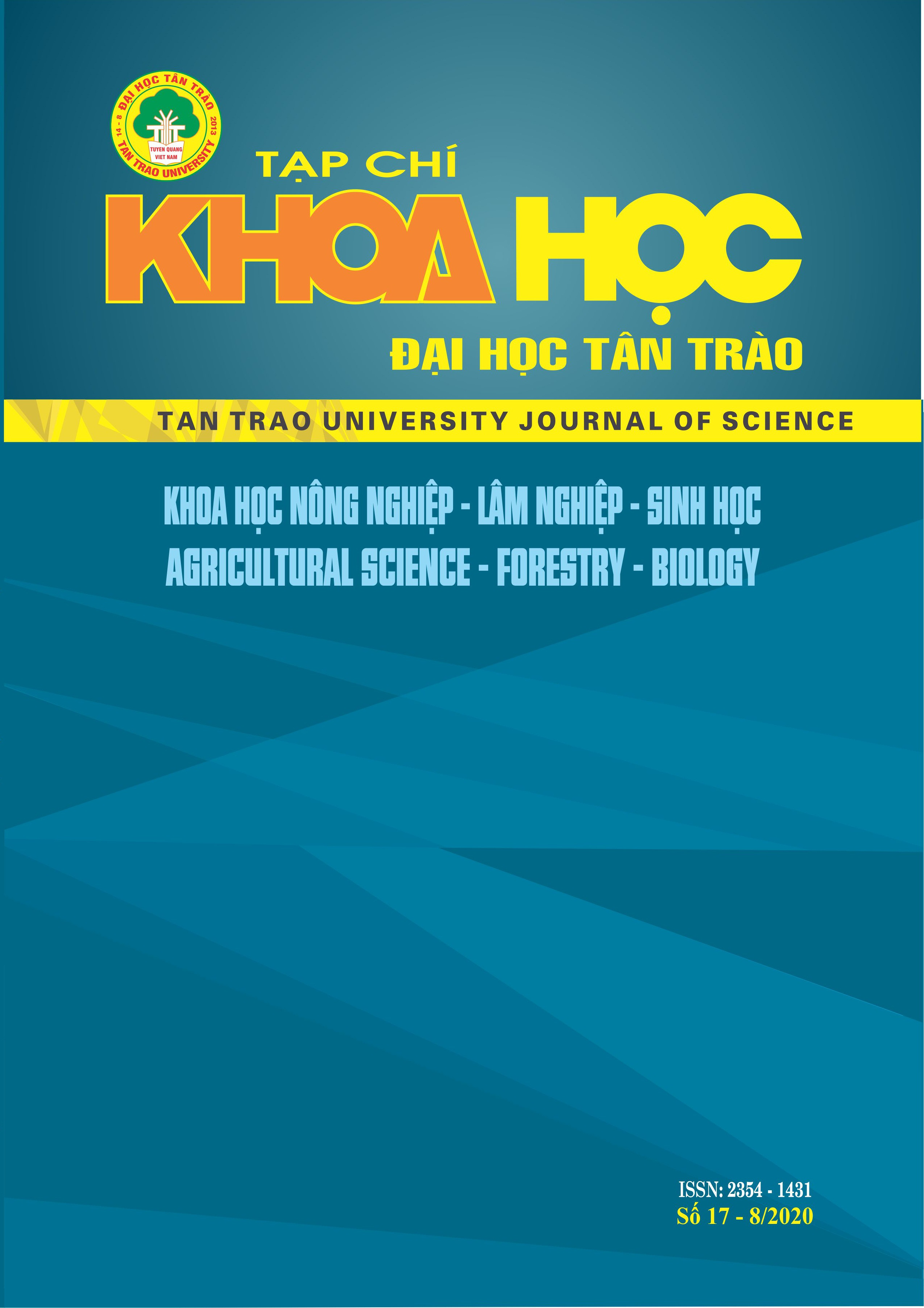NHÂN GIỐNG LOÀI RÂU HÙM (TACCA CHANTRIERI ANDRE) BẰNG PHƯƠNG PHÁP NHÂN GIỐNG SINH DƯỠNG Ở TRƯỜNG ĐẠI HỌC TÂN TRÀO, TUYÊN QUANG
DOI:
https://doi.org/10.51453/2354-1431/2020/383Từ khóa:
Giâm hom, Râu hùm, Hom giống, IAA, IBA, α-NAA.Tóm tắt
Râu hùm (Tacca chantrieri Andre) là loài cây thuốc quý, có công dụng chữa bệnh thấp khớp, dùng uống trị viêm loét dạ dày và hành tá tràng, viêm gan, huyết áp cao, bỏng lửa, lở ngứa…[7,10]. Mặc dù chưa bị khai thác nhiều quá mức song nạn phá rừng và khai thác rừng đã trực tiếp làm thu hẹp diện phân bố và khả năng trữ lượng tự nhiên của cây. Việc nghiên cứu nhân giống loài Râu hùm nhằm bảo tồn và phát triển các loài cây thuốc của tỉnh Tuyên Quang. Kết quả nghiên cứu nhân giống Râu hùm bằng phương pháp sinh dưỡng cho thấy, hom giâm ở các vị trí hom khác nhau (hom ngọn, hom giữa và hom gốc) có kích thước 10cm cho tỷ lệ sống cao hơn, trong đó hom giữa (kích thước 10cm) sau 30 ngày, 60 ngày và 90 ngày đều cho kết quả cao nhất với các giá trị tương ứng về tỷ lệ hom sống (95,9%, 78,5% và 67,8%). Hom giữa (10cm) cho số chồi/hom cao nhất. Khi nhân giống Râu hùm bằng hom giữa (10cm) có sử dụng các chất kích thích sinh trưởng và nồng độ sử dụng các chất đó tới tỷ lệ sống và ra rễ cho thấy: sau 90 ngày, công thức cho tỷ lệ sống cao nhất là hom xử lý IAA với nồng độ 1500ppm đạt 100%, cao hơn nhiều so với đối chứng. Tiếp đến là IBA với tỷ lệ 98,5%, còn lại α-NAA có sự tác động lên hom giâm thấp nhất. Loại chất kích thích sinh trưởng và nồng độ sử dụng đã ảnh hưởng rõ rệt đến tỷ lệ ra rễ và số rễ trung bình/hom, khi nồng độ tăng từ 500ppm lên đến 1000ppm, đặc biệt lên đến 1500ppm thì tỷ lệ ra rễ và số rễ trung bình/hom có xu hướng tăng theo. Công thức 9 với chất kích thích IBA ở nồng độ 1500ppm cho tỷ lệ cao nhất.
Tải xuống
Tài liệu tham khảo
1. Do Huy Bich, Dang Quang Chung, Bui Xuan Chuong, Nguyen Thuong Dong, Do Trung Dam, Pham Van Hien, Vu Ngoc Lo, Pham Duy Mai, Pham Kim Man, Doan Thi Nhu, Nguyen Tap, Tran Toan (2006). Medicinal plants and medicinal animals in Vietnam, vol. 1, pages 940-943. Publisher: Science and Technology, Hanoi.
2. Do Tat Loi (2006), Vietnamese medicinal plants and herbs, Hanoi Medical Publisher , Hanoi.
3. Le Dinh Kha, Nguyen Hoang Nghia, Pham Van Tuan, Doan Thi Bich (1997), Research on cuttings of Eucalyptus. Results of scientific research on forest seed selection, T2. Agricultural Publisher: p. 84-94.
4. Le Dinh Kha et al (2003), Selection, creation and propagation of some major forest plant species in Vietnam, Agriculture Publisher:Hanoi.
5. Nguyen Mong Hung (2005), Plant breeding techniques, Agriculture Publisher Hanoi.
6. Nguyen Hai Tuat, Nguyen Trong Binh (2005), Exploiting and using SPSS for data processing in Forestry, Agriculture Publisher Hanoi.
7. Nguyen Thi Hai (2018), research medicinal plant resources to propose solutions to conserve and sustainably use a number of valuable species in Na Hang Nature Reserve, Tuyen Quang province, PhD thesis in biology, Hanoi.
8. Nguyen Tien Ban (Editor, 2003), List of Plant Species of Vietnam, vol. 2, Agriculture Publisher, Hanoi, pp. 144-145.
9. Institute of Medicinal Materials (2016), List of Vietnamese medicinal plants, Science and Technology Publisher, Hanoi, page 437.
10. Vo Van Chi, Dictionary of Vietnamese medicinal plants. Vol. 1, 2, Hanoi Medical Publisher, Hanoi,2012.
Tải xuống
Đã Xuất bản
Cách trích dẫn
Số
Chuyên mục
Giấy phép

Tác phẩm này được cấp phép theo Giấy phép Quốc tế Creative Commons Attribution-ShareAlike 4.0 .
Bài báo được xuất bản ở Tạp chí Khoa học Đại học Tân Trào được cấp phép theo giấy phép Ghi công - Chia sẻ tương tự 4.0 Quốc tế (CC BY-SA). Theo đó, các tác giả khác có thể sao chép, chuyển đổi hay phân phối lại các bài báo này với mục đích hợp pháp trên mọi phương tiện, với điều kiện họ trích dẫn tác giả, Tạp chí Khoa học Đại học Tân Trào và đường link đến bản quyền; nêu rõ các thay đổi đã thực hiện và các nghiên cứu đăng lại được tiến hành theo cùng một bản quyền.
Bản quyền bài báo thuộc về các tác giả, không hạn chế số lượng. Tạp chí Khoa học Tân Trào được cấp giấy phép không độc quyền để xuất bản bài báo với tư cách nhà xuất bản nguồn, kèm theo quyền thương mại để in các bài báo cung cấp cho các thư viện và cá nhân.
Mặc dù các điều khoản của giấy phép CC BY-SA không dành cho các tác giả (với tư cách là người giữ bản quyền của bài báo, họ không bị hạn chế về quyền hạn), khi gửi bài tới Tạp chí Khoa học Đại học Tân Trào, tác giả cần đáp ứng quyền của độc giả, và cần cấp quyền cho bên thứ 3 sử dụng bài báo của họ trong phạm vi của giấy phép.






